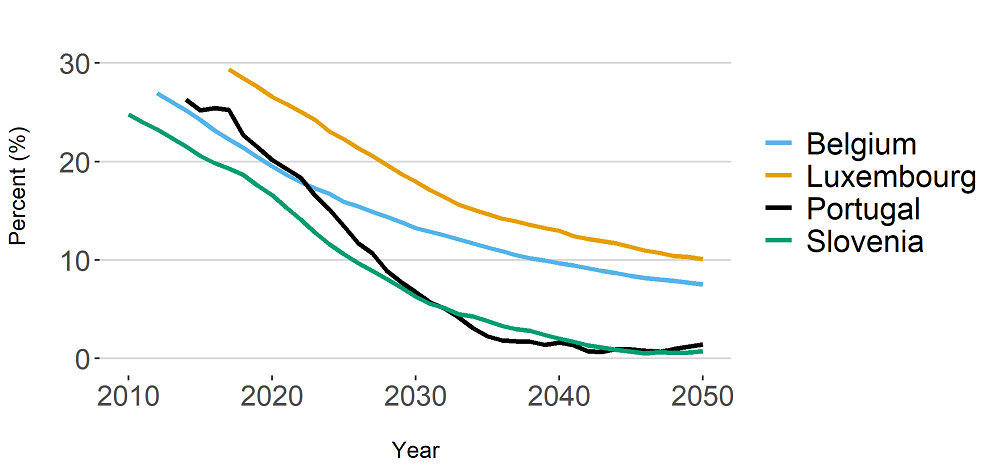The future of the gender pension gap
In brief
The Gender Pension Gap is projected to decrease sharply over the coming 20 years, as a result of narrowing gender differences in employment rates and in wages during the last decades.
To read
See our publication on main findings
The Gender Pension Gap is projected to decrease over the coming 20 years
 The Gender Pension Gap (GPG) is projected to decrease sharply over the coming 20 years. This is true under the AWG scenario, which incorporates projections of labour market developments from the EU’s Ageing Working Group (AWG). It is also the case under the Constant scenario, where labour market structures are assumed to remain at their current level. The most important factor driving the decline in the GPG are the sharply decreasing employment gaps in Belgium, Luxembourg and Portugal in recent decades. Narrowing gender pay gaps are also likely to play an important role. In Slovenia as well, the decreasing and very low GPG is driven by high women’s activity rates during the latest decades and especially the increasing activity rates of women at higher ages (55 and over). An important reason why the GPG stays at a higher level in Belgium and Luxembourg than in Portugal and Slovenia is that in the former countries there is a large gender difference in the part-time working rate, while part-time working rates are low for both genders in Portugal and Slovenia. Part-time working rates remain unchanged in the projections.
The Gender Pension Gap (GPG) is projected to decrease sharply over the coming 20 years. This is true under the AWG scenario, which incorporates projections of labour market developments from the EU’s Ageing Working Group (AWG). It is also the case under the Constant scenario, where labour market structures are assumed to remain at their current level. The most important factor driving the decline in the GPG are the sharply decreasing employment gaps in Belgium, Luxembourg and Portugal in recent decades. Narrowing gender pay gaps are also likely to play an important role. In Slovenia as well, the decreasing and very low GPG is driven by high women’s activity rates during the latest decades and especially the increasing activity rates of women at higher ages (55 and over). An important reason why the GPG stays at a higher level in Belgium and Luxembourg than in Portugal and Slovenia is that in the former countries there is a large gender difference in the part-time working rate, while part-time working rates are low for both genders in Portugal and Slovenia. Part-time working rates remain unchanged in the projections.
What if there was complete gender equality on the labour market from 2021 on?
 This graph shows the projected development of the GPG under the – admittedly unrealistic – hypothesis that labour market participation rates are equalised across men and women from 2021 on (“Equal employment” scenario). In the “Equal employment and wages” scenario there are, additionally, no gender differences in part time employment and in hourly wages. The combined impact of these scenarios in 2050 is negligible in Slovenia, small in Belgium and somewhat larger in Portugal and Luxembourg. One reason for these dampened effects is that the complete equalisations of employment and wages from 2021 on will have only partially affected the population of retirees in 2050. In Slovenia, moreover, employment rates for most age groups are approximately the same for women and men even in the AWG scenario, and the gender pay gap is only around 8% in 2019. Equalization of wages, in addition to equal employment rates, will lead to a further closing of the Gender Pension Gap in the long run when fully affecting all retirees. In Belgium and Luxembourg part-time working rates are also set equal between women and men in that scenario, and this makes an important contribution to the closing of the Gender Pension Gap.
This graph shows the projected development of the GPG under the – admittedly unrealistic – hypothesis that labour market participation rates are equalised across men and women from 2021 on (“Equal employment” scenario). In the “Equal employment and wages” scenario there are, additionally, no gender differences in part time employment and in hourly wages. The combined impact of these scenarios in 2050 is negligible in Slovenia, small in Belgium and somewhat larger in Portugal and Luxembourg. One reason for these dampened effects is that the complete equalisations of employment and wages from 2021 on will have only partially affected the population of retirees in 2050. In Slovenia, moreover, employment rates for most age groups are approximately the same for women and men even in the AWG scenario, and the gender pay gap is only around 8% in 2019. Equalization of wages, in addition to equal employment rates, will lead to a further closing of the Gender Pension Gap in the long run when fully affecting all retirees. In Belgium and Luxembourg part-time working rates are also set equal between women and men in that scenario, and this makes an important contribution to the closing of the Gender Pension Gap.
For more information
- Barslund, Mikkel, Gijs Dekkers, Karel Van den Bosch, 2021. 'Projections of the Gender Pension Gap: comparative report'. project MIGAPE, Work Package 3, Belgian Federal Planning Bureau, Brussels.
- Dekkers, Gijs, Karel Van den Bosch, 2021. 'Projections of the Gender Pension Gap in Belgium using MIDAS'. project MIGAPE, Work Package 3, Belgian Federal Planning Bureau, Brussels.
- Kirn, Tanja, Nicolas Baumann, 2021. 'Project MIGAPE: Work Package 3: Results of the Dynamic Simulations for Switzerland'. Center for Economics, University of Liechtenstein, Liechtenstein.
- Kump, Natasa, Nada Stropnik, 2021. 'Projections of the Gender Pension Gap in Slovenia using DYPENSI'. Institute for Economic Research, Ljubljana.
- Liegeois, Philippe, 2021. 'Projections of the Gender Pension Gap in Luxembourg using LU-MIDAS 2020'. Luxembourg Institute for Socio-Economic Research (LISER), Esch-sur-Alzette.
- Moreira, Amilcar, Karen Wall, 2021. 'Projections of the Gender Pension Gap in Portugal using DYNAPOR'. MIGAPE, Work Package 3, Institute of Social Sciences, University of Lisbon, Lisbon.